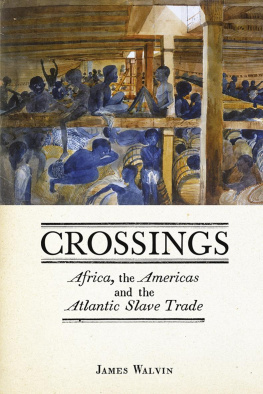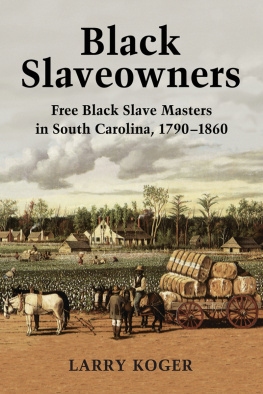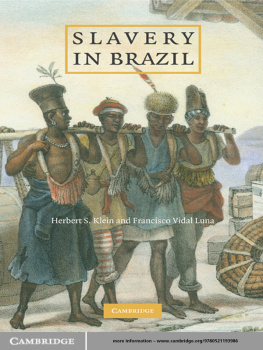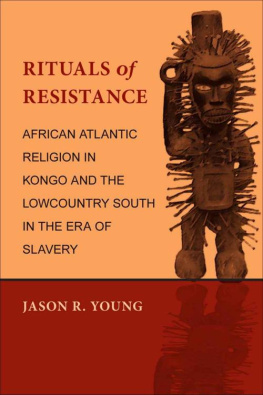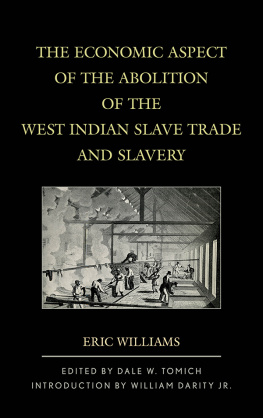SHAPING THE NEW WORLD
African Slavery in the Americas, 15001888
ERIC NELLIS

Copyright University of Toronto Press Incorporated 2013
Higher Education Division
www.utppublishing.com
All rights reserved. The use of any part of this publication reproduced, transmitted in any form or by any means, electronic, mechanical, photocopying, recording, or otherwise, or stored in a retrieval system, without prior written consent of the publisheror in the case of photocopying, a licence from Access Copyright (Canadian Copyright Licensing Agency), One Yonge Street, Suite 1900, Toronto, Ontario M5E 1E5is an infringement of the copyright law.
Library and Archives Canada Cataloguing in Publication
Nellis, Eric Guest, 1938
Shaping the New World: African slavery in the Americas, 15001888/Eric Nellis.
(International themes and issues; v. 3)
Includes bibliographical references and index. Issued in print and electronic formats. ISBN 978-1-4426-0555-8 (pbk.).ISBN 978-1-4426-0764-4 (bound).ISBN 978-1-4426-0556-5 (pdf).ISBN 978-1-4426-0557-2 (epub)
1. SlaveryBrazilHistory. 2. SlaveryCaribbean AreaHistory. 3. SlaveryLatin AmericaHistory. 4. SlaveryUnited StatesHistory. 5. SlavesAmericaSocial conditions. 6. Slave tradeAfricaHistory. 7. Antislavery movementsAmericaHistory. I. Canadian Historical Association II. Title. III. Series: International themes and issues (Toronto, Ont.); v. 3
HT871.N45 2013 306.3'62097 C2013-903280-0 C2013-903281-9
We welcome comments and suggestions regarding any aspect of our publicationsplease feel free to contact us at .
North America
5201 Dufferin Street
North York, Ontario, Canada, M3H 5T8
2250 Military Road
Tonawanda, New York, USA, 14150
ORDERS PHONE: 1-800-565-9523
ORDERS FAX: 1-800-221-9985
ORDERS E-MAIL:
UK, Ireland, and continental Europe
NBN International
Estover Road, Plymouth, PL6 7PY, UK
ORDERS PHONE: 44 (0) 1752 202301
ORDERS FAX: 44 (0) 1752 202333
ORDERS E-MAIL:
This book is printed on paper containing 100% post-consumer fibre.
The University of Toronto Press acknowledges the financial support for its publishing activities of the Government of Canada through the Canada Book Fund.
Printed in Canada
Contents
Maps and Tables
Maps
Tables
Acknowledgements
The author is in debt to the generations of scholars and political and civil rights activists who have illuminated the role of African slavery in the histories of the post-Columbian Americas to where it is now understood as fundamental to the shaping of modern American societies.
The approach taken in this book was in part shaped by a course in comparative slavery in the Americas that I taught for many years at the University of British Columbia. I thank the many students who took part in History 444 for their influence on the way the subject can be taught. I am grateful for the contribution of Professor Beverly Lemire of the University of Alberta who helped refine the original manuscript and speed its completion.
I thank Dr. Tatiana van Riemsdijk of the UBC History Department for her conversations and advice on the use of sources for slave women, Eric Leinberger for the maps, Betsy Struthers for her excellent copyediting, and Natalie Fingerhut and the editorial staff at UTP and the anonymous readers of the first draft for their encouragement and expertise.
My greatest thanks are to my wife Vicky McAulay who read the first draft. Her editorial talents greatly influenced the final composition.
1 The Setting for New World Slavery: An Overview
The traditions of both slavery and race are part and parcel of the evolution of Western culture. Nevertheless, the narrow correlation of slavery and race is a peculiarly American [New World] innovation.
Franklin W. Knight, Slavery, Race, and Social Structure (1974)
Between the sixteenth and nineteenth centuries, the peoples of Africa, America, and Europe were linked to form new societies in what historian Robin Blackburn calls the American crucible.
Slaverys uneven distribution led to slave societies, such as those in Virginia, Cuba, Jamaica, and Bahia in Brazil. These differed from slaveholding societiesfor example, in New England, the highlands of Mexico, Argentina, the Andes, the Amazon and Quebec, or for that matter above 40 degrees north latitude or below 40 degrees south latitudewhere slavery had limited or little application because of climate, geography, and settlement objectives. To make the distinction clearer, what we understand as slave societies were those that were sustained and defined by African slavery. In slaveholding societies, the numbers of slaves were too small and their functions were incidental and not vital in the shaping of the society. Moreover, it must be emphasized that Europeans did not fix their own people as property. Slavery in the Americas was racially determined and settled exclusively on Africans or peoples of African descent, legally bound as property for life as chattels. The exception to this was the enslavement of natives, another matter of racial determinism, but a practice that was in decline early in the colonial period and was never as aggressively applied as was the case with Africans. In fact, the Spanish and Portuguese retreated from their early hopes of using extensive native labour for their plantations. Natives in the lowland tropical zones were either decimated by European diseases or were difficult to control or indoctrinate in the rigours of repetitive, disciplined agricultural work. Their numbers in some areas were simply too sparse.
African slaves underwrote the economic and political elites who emerged in Brazil, the southern British North American mainland colonies (the United States after the American Revolution), the Caribbean, and the mining zones of Spanish Peru, Brazils Minas Gerais, and elsewhere. The first permanent settlements in Brazil depended on investments in sugar, and African slaves appeared as early as the 1550s, a dependency that grew to where an eighteenth-century Jesuit priest, appealing for a more humane treatment of slaves, could announce succinctly: The slaves are the hands and feet of the sugar-mill owner [senhor de engenho] because without them it is not possible in Brazil to set up, maintain, and develop a plantation, nor to have a functioning mill. Slavery shaped the Americas particular versions of class, not only as it separated rich from poor whites, and all whites from slaves, but as it graded the latter increasingly in castes delineated in the gradations of colour from dark to light in the mixed racial populations of Latin America. Meanwhile, Western Europe became a cocoon for whites and whiteness, remaining largely aloof from racial diversification until the latter part of the twentieth century when it became a target for increased non-white immigration from its former colonies.
The Portuguese had access to slaves from the West African coast as early as the middle of the fifteenth century. They found existing slave trading patterns and met enthusiastic intermediaries. In the century before they went to America, they were using African slaves at home and in the Atlantic islands of the Azores, Madeira, and Cape Verde as were the Spanish in the Canaries. Moreover, in a balanced and delicate double standard, the Iberians (Spanish and Portuguese) with a long experience of slaveholding, acknowledged that Africans could be converted to Christianity, have Christian souls, and still become property and that while Christianity might lead to manumission (freedom) for some, this required the grace of the owner. On the other hand, the British and the Dutch who had no tradition of domestic slaveholding were for a long time hesitant to grant Christian status to slaves. Along with the French, they were unencumbered by the legal and customary restraints on Iberians and, as we shall see, were relatively free to devise their own codes in the colonies.



